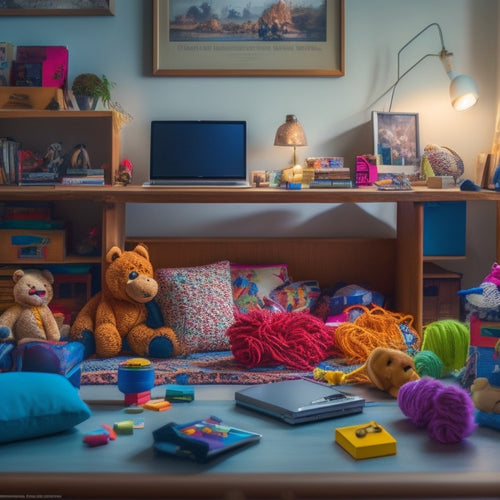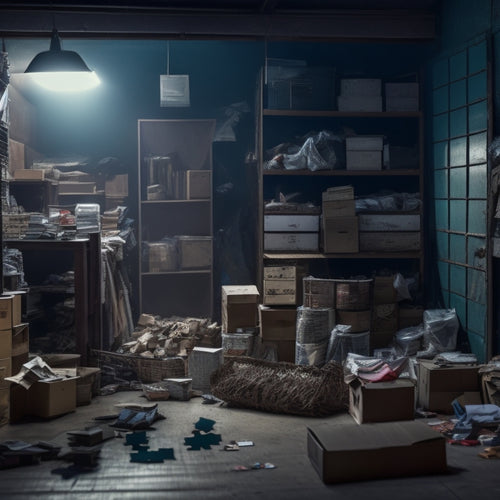
Revolutionize Your Dining Room Storage Organization
Share
I'm ready to ditch the cluttered cabinet chaos and transform my dining room into a stylish oasis! First, I'll empty and assess my cabinets, taking stock of my tableware treasure trove. Next, I'll categorize and assign storage, grouping similar items and prioritizing frequently used ones. Finally, I'll optimize for ease, designating spots and ensuring accessibility, so my dinner parties become stress-free celebrations. With a little creativity, I'll establish a storage system that's both beautiful and functional, making my dining room the perfect haven for memorable gatherings – and I'm just getting started, uncovering a world of possibilities!
Key Takeaways
• Empty and assess cabinets to take control of chaotic tableware storage and create an organized system.
• Categorize and assign storage by grouping similar items, prioritizing frequently used ones, and considering color coding and pattern sorting.
• Designate specific spots for each group, ensuring accessibility and beautiful display while catering to unique needs.
• Enhance accessibility and visibility by showcasing prized possessions, adding elegance with china sets, and incorporating helper shelves and separator plates.
• Establish a functional and beautiful storage system that balances aesthetics with efficiency, ensuring every item has a designated home.
Empty and Assess Your Cabinets
As I stand before my cabinets, I'm met with a challenging task: unloading the sheer volume of tableware that's been accumulating for years, each piece stacked haphazardly on top of the other like a precarious game of Jenga.
The chaos is overwhelming, with plates, chargers, and glasses teetering on the edge of collapse. It's time to take control and empty these cabinets, evaluating my inventory as I go.
I'll gather similar items from different cabinets, taking stock of what I've and what I need to keep. This is the first step in creating a cabinet organization system that works for me, not against me.
Categorize and Assign Storage
I spread out my gathered tableware, grouping similar items together as I survey the array of plates, chargers, and glasses before me, each one telling a story of memories made and occasions celebrated.
Now, it's time to categorize and assign storage. I prioritize my items by deciding what's most frequently used and what can be stored away.
Here are my top three considerations for categorizing my tableware:
-
Color code: I group similar hues together to create a visually pleasing display.
-
Pattern sort: I separate patterns and designs to optimize storage and make it easier to find what I need.
-
Prioritize: I store my most prized possessions in visible areas, ensuring they're easily accessible and admired.
Optimize Storage for Ease
Now that I've categorized my tableware, I'm ready to optimize storage for ease by assigning a designated spot for each group, ensuring that every item is effortlessly accessible and beautifully displayed.
I'm creating storage solutions that cater to my unique needs, making sure everything has a dedicated home. For instance, I'm storing casual plates on shelves with one pattern per shelf, making it easy to grab what I need.
Meanwhile, my prized china sets are showcased in visible areas, adding a touch of elegance to the room. Accessibility tips like adding helper shelves and separating charger plates have also been incorporated, streamlining table setting efficiency.
With every item in its perfect spot, I can finally enjoy a stress-free dining experience.
Frequently Asked Questions
How Do I Decide Which Items to Keep and Which to Donate or Discard?
As I curate my collection, I weigh each item's sentimental value against my personal style, asking: Does it spark joy? Does it reflect me? If not, I let it go, liberating space for treasured pieces that tell my story.
Can I Store My Fine China in a Humid Basement or Attic?
Did you know 60% of fine china is damaged due to improper storage? I wouldn't dare store my fine china in a humid basement or attic, where climate control and moisture management are essential, risking irreparable harm to my treasured pieces.
What Is the Best Way to Protect Fragile Items From Breaking?
"I carefully wrap my fragile items in Bubble Wrap, ensuring each piece is snugly protected, then place them in storage containers with Foam Inserts, providing an extra layer of cushioning to prevent breaks and shattering."
How Often Should I Clean and Dust My Dining Room Storage?
"As I dust off my grandmother's vintage etiquette book, I vow to maintain a dusting schedule, tidying my dining room storage weekly, and committing to a monthly deep cleaning routine to keep my treasures shining."
Can I Use Decorative Storage Bins to Hide Cluttered Areas?
I adore using decorative storage bins to conceal cluttered areas, thoughtfully selecting bins that complement my dining room's aesthetic, ensuring a seamless integration that exudes sophistication and refinement, while keeping my storage organized and easily accessible.
Conclusion
With a flicker of flair, I've finally freed my dining room from its former frazzle. Cabinets now shine with serenity, and every piece has its perfect place.
The once-jumbled jungle is now a tranquil tableau, where treasures are tastefully tucked away. By banishing clutter and assigning homes, I've birthed a brilliant buffet of beauty and functionality.
My dining room storage is now a symphony of simplicity, where every meal is a masterpiece.
Related Posts
-

Why Cluttered Homes Need Professional Online Guidance
You're likely no stranger to the feeling of being overwhelmed by clutter, and it's precisely this sense of paralysis ...
-

What's Missing in Your Storage Space Solution?
You're likely overlooking hidden opportunities to optimize your kitchen's storage capacity, leading to inefficiencies...
-

7 Best Corner Shelving Units for Home
You're looking to optimize your home's corner spaces with stylish and functional shelving units. Corner shelves are a...


